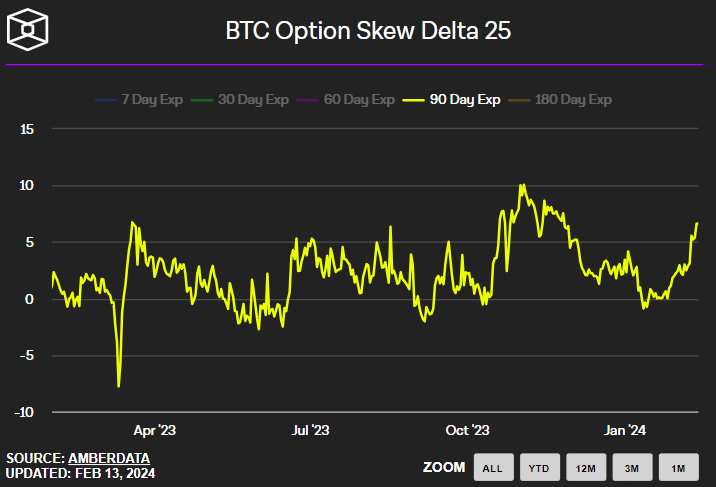Bitcoin Price Drops Back Below $49,000 After Hot US CPI Data Deals Blow to Fed Rate Cut Bets – Where Next for BTC?

The Bitcoin (BTC) price has dipped back below $49,000, a near $1,500 turnaround from the two-year highs it hit near $50,400 earlier in the session, in wake of the release of hotter-than-expected US Consumer Price Index (CPI) data for January.
Last changing hands around $48,500 on major cryptocurrency exchanges, the Bitcoin price was last down nearly 3% on the day.

The headline CPI rose 0.3% MoM in January, above expectations MoM price pressures to remain at 0.2%.
Meanwhile, Core CPI accelerated to 0.4% MoM from 0.3% in December, above expectations to remain unchanged at 0.3%.
The unexpected rise in inflationary pressures suggests Fed policymakers are right to be cautious about starting a rate-cutting cycle.
The data unsurprisingly forced macro investors to pull back on rate cuts bets.
As per the CME’s FedWatch Tool, money markets now imply a less than 40% chance that cuts start in May.
That’s down from over 60% just one day ago.
However, the market’s consensus bet remains that rate cuts start in H1 2024.
Money markets still imply a near-80% chance that cuts begin by June, down narrowly from 90% one day ago.
Bitcoin Price Pulls Lower as Traders Pull Back on Rate Cut Bets
The prospect of interest rates remaining at higher levels for longer as the Fed takes a more cautious approach to rate cuts in light of hot US inflation data has seen US government bond yields and the US Dollar Index (DXY) vault higher on Tuesday, with the US 10-year yield last around 10 bps higher on the day near 4.3%, and the DXY last at more than two-month highs above around 104.75.
The jump in US yields is weighing on interest-rate-sensitive assets, like US equities, gold and crypto.
The S&P 500 dipped over 1% on Tuesday and is back under 5,000.
Gold was last down around 1.4% and back under $2,000 for the first time in two months.
And, as previously noted, Bitcoin has also come under pressure.
Rising yields on risk-free assets like US government bonds reduce the incentive to hold riskier assets (like stocks and Bitcoin) and/or non-yielding assets (like Gold and Bitcoin).
Spot Bitcoin ETF Inflows Remain Strong
The Bitcoin price’s latest drop puts it on course to post its first red day in eight sessions.
Given the Bitcoin price had, at earlier session highs near $50,400, pumped up over 18% since the start of last week, some will see an intra-day pullback as well overdue.
But traders should note that the latest price pullback may not last long.
That’s because, in recent months, macro factors haven’t been a major driver of the Bitcoin price.
Fed rate cut bets have been reduced significantly since the start of the year.
But the Bitcoin price has nonetheless been able to rally over 15%.
That’s because the focus has been on spot Bitcoin ETF approvals in the US just over one month ago.
Indeed, a slowing of GBTC outflows and strengthening of inflows into its competitors was behind last week’s pump.
And spot Bitcoin ETFs have continued to see strong inflows at the start of this week.
As per Farside.co.uk data, spot Bitcoin ETFs hoovered up over 10K BTC tokens on Monday.
Number of #Bitcoin bought by the Big 4 ETFs each trading day
Day 22 = 2/12/24 🧮 Only 900 $BTC are mined daily. $IBIT $FBTC $ARKB $BITB pic.twitter.com/0urMF6LVSP
— HODL15Capital 🇺🇸 (@HODL15Capital) February 13, 2024
Net inflows were above $400 million for a third straight day.
As Michael Saylor has pointed out, the current demand for BTC from spot ETFs is 10x what miners produce daily.
As per Bitcoin’s current issuance schedule, under 1,000 new BTC tokens are created each day.
And this number is set to half in April when the four-yearly Bitcoin halving takes place.
Where Next for the Bitcoin Price?
Given the Bitcoin market is currently enjoying a demand shock and will soon experience a supply shock, its no wonder price bets are growing more bullish.
The 25% delta skew of 90-day Bitcoin options recently rose to its highest since November at nearly 7.

That means investors are paying a bigger premium for options that protect against price upside versus price downside than they have in over two months.
Net inflows into spot Bitcoin ETFs and the halving aren’t the only tailwinds.
Macro is expected to eventually turn into a tailwind when the Fed finally does start cutting rates later this year.
Meanwhile, safe-haven demand could yet come surging back as trouble in the US regional bank sector bubbles.
The KBW Regional Bank Index continues to underperform after New York Community Bancorp’s ugly recent earnings weigh on sentiment.
The index was last down around 12% this year.
Bitcoin traders will recall a 50% Bitcoin price pump in two week’s last March on bank crisis concerns.
Regional US bank troubles could be about to get a lot worse with the Fed’s emergency program it introduced last March set to expire in one month.
Investors should continue to view Bitcoin price dips as buying opportunities.
Bitcoin may not remain back under $50,000 for long.
A retest of all-time highs at $69,000 later this year remains very much on the cards.









